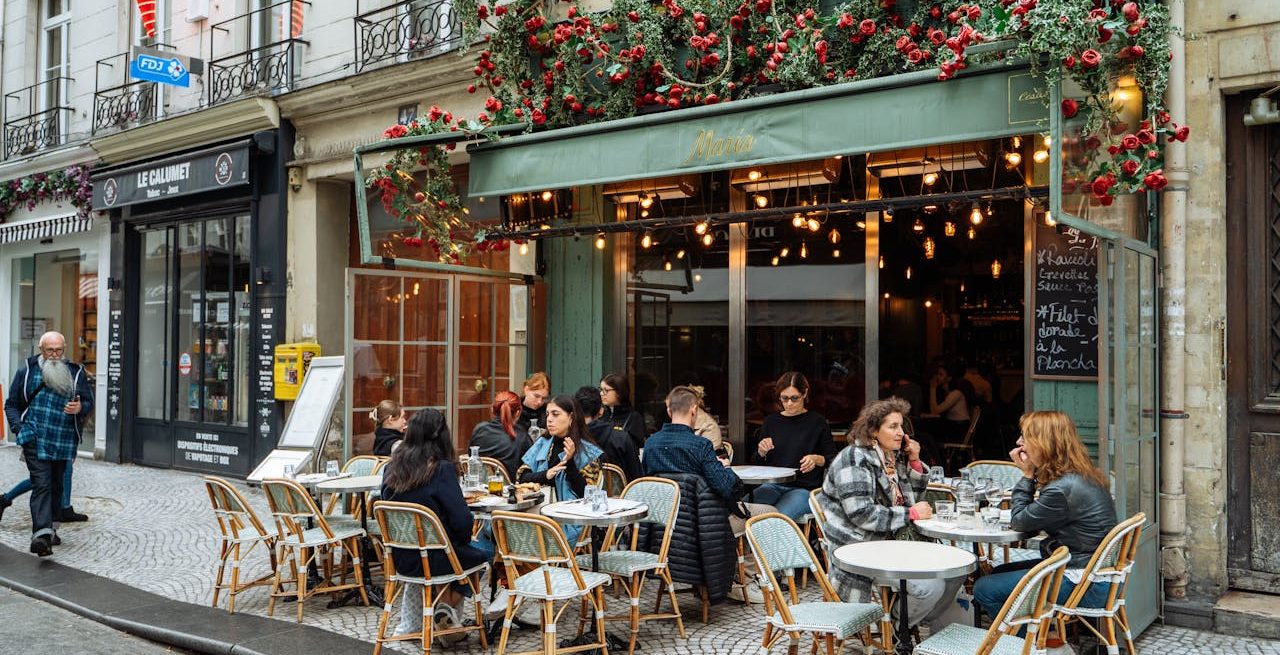Lessons from French Bistros: How Small Restaurants Deliver Big Experience
4 Min Read By Kenny Dunn
French bistros are more than just places to eat. They’re cultural icons that embody the art of living well. These small, unassuming eateries—often with fewer than 20 tables—have long been celebrated for their cozy charm, unpretentious cuisine, and a welcoming spirit that turns every meal into a moment of connection.
As of 2024, Paris alone boasts approximately 18,000 bistros, making up 10 percent of France’s restaurant scene. Far from being relics, bistros remain vibrant, offering timeless lessons for small restaurants aiming to leave a lasting mark.
This article explores their charm, global influence, and the key elements that fuel their success.
Introduction: The Charm of French Bistro Culture
At the heart of French bistro culture lies an effortless charm that transforms dining into something personal and profound. Born in the 19th century as modest spots serving workers affordable fare like onion soup and crepes, bistros have become symbols of France’s culinary soul.
Their appeal isn’t in extravagance but in simplicity—chalkboard menus scribbled with daily specials, circular tables, folding chairs, and the clink of wine glasses. Unlike larger, formal dining establishments with starched linens and sprawling menus, bistros offer a relaxed intimacy that swaps stiff elegance for a warm, lived-in feel. They are top spots for the best food in France.
The Global Influence of French Bistros on Dining Culture
The influence of French bistros stretches far beyond France’s borders, shaping dining cultures across the globe. In cities like New York, you’ll find eateries that mirror the bistro’s casual sophistication, while Tokyo’s intimate wine bars reflect a similar ethos of warmth and simplicity.
Even rural cafés in distant locales have adopted the bistro blueprint: hearty food served in a welcoming space. This influence stems from a philosophy that prioritizes quality over extravagance.
Chefs and restaurateurs worldwide have taken cues from the bistro model. The farm-to-table movement, for instance, owes a debt to bistros’ early reliance on local, seasonal ingredients, a practice rooted in necessity rather than trendiness. Similarly, the rise of casual fine dining echoes the bistro’s knack for blending refinement with accessibility.
Key Elements of Success: What Makes French Bistros Stand Out
French bistros thrive by mastering a handful of key elements that elevate them beyond mere eateries into memorable experiences:
Intimate Ambiance
The heart of a bistro lies in its cozy, inviting atmosphere. Small dining rooms feature dim lighting, vintage decor, and closely spaced seating that fosters conversation. This intimacy creates a sense of belonging that turns dining into a personal, almost home-like experience.
Authenticity
Authenticity is at the heart of every French bistro. From the dishes to the décor, bistros prioritize staying true to their roots while showcasing the rich history and culture of French culinary traditions.
Simple, rustic dishes like coq au vin, cassoulet, and steak frites are everyday staples, offering diners a taste of the comfort food generations have loved. This commitment to authenticity also extends to the overall experience.
Personalized Service
Unlike the formality of fine dining, where customers may feel like just another face in the crowd, bistro service is warm and personalized. The staff acts as "culinary guides," weaving a connection between the kitchen and the table. They:
● Offer tailored recommendations based on a guest’s tastes
● Share stories behind the day’s specials
● Often remember regulars’ preferences, from their favorite wine to their preferred seat by the window
This practice builds loyalty, turning first-time visitors into lifelong patrons.
Dining Experiences Shaped by the Atmosphere
The interplay of savory aromas, muted lighting, and the gentle clatter of plates craft an immersive experience that heightens every bite. Bistros understand that dining is as much about emotion as it is about sustenance, leaving guests with memories that linger long after the meal ends.
This sensory symphony is no accident. It’s a carefully curated balance that draws diners into the moment. The faint hum of conversation blending with the sizzle of a pan from an open kitchen and the rich scent of a simmering bourguignon all create a living tableau.
Adaptability
Though bistros are steeped in tradition, their success also lies in their adaptability. Today, French bistros have shown great flexibility, embracing modern dining trends without sacrificing the heart and soul of their origins.
This adaptability allows bistros to stay relevant even as dining preferences shift. It also ensures that guests have fresh, exciting experiences each time they visit, even while enjoying the same comforting flavors that have defined the bistro experience for generations.
Balancing Tradition with Innovation
While honoring classics, bistros aren’t afraid to evolve. This innovation has led to bistronomy, a culinary trend combining fine dining creativity and the simplicity of traditional bistro fare. To keep up with modern tastes and habits, bistros adopt smart innovations without losing their soul. Here’s how they do it:
● Plant-based twists: Chefs rework dishes like cassoulet with veggies or legumes to suit diverse diets.
● Tech-savvy tools: Online reservations and ordering streamline service for busy guests.
● Social media buzz: Instagram and other platforms showcase daily specials and cozy vibes to draw crowds.
French bistros offer a masterclass on how small restaurants can deliver big experiences. From their intimate ambiance and authentic cuisine to their personalized service and adaptability, bistros excel in creating memorable dining moments that larger establishments often fail to replicate. Small restaurants striving to create a unique and unforgettable experience for their guests should focus on authenticity, atmosphere, and innovation.


